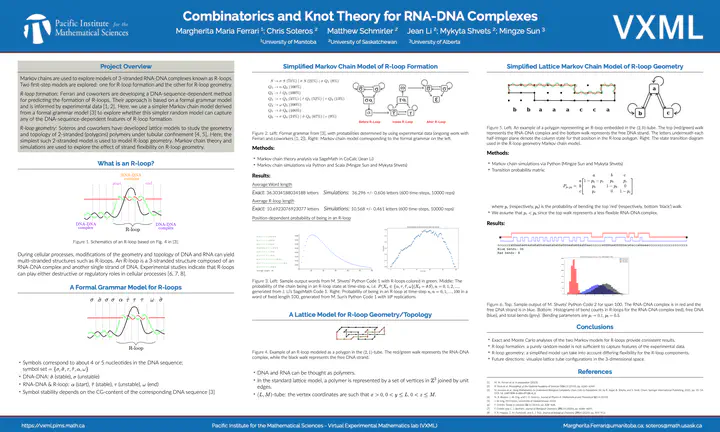Project Leaders
- Margherita Maria Ferrari, University of Manitoba
- Chris Soteros, University of Saskatchewan
Postdoctoral Mentor
- Matthew Schmirler, University of Saskatchewan
Undergraduate Team Members
- Mingze Sun, University of Alberta
- Mykyta Shvets, University of Saskatchewan
- Jean Li, University of Saskatchewan
Problem Statement
DNA and RNA contain the genetic code of life. They typically occur in the form of long polymers that are subjected to high levels of confinement. During cellular processes, modifications of the geometry and topology of DNA and RNA can yield multi-stranded structures such as R-loops. An R-loop is a 3-stranded structure composed of an RNA-DNA complex and another single strand of DNA. Experimental studies indicate that R-loops can play either destructive or regulatory roles in cellular processes. Thus, it is important to determine the factors influencing R-loop formation and stability. It is known that both DNA sequence and topology affect R-loop formation, however, little is known about their topological entanglement.
We propose to use techniques from knot theory and combinatorics to address questions about the geometry and topology of 3-stranded polymers such as R-loops. Ferrari and coworkers are developing a sequence-dependent method for predicting the location of R-loops based on a formal grammar model. Given a DNA sequence, the model can be applied to predict the probabilities of R-loop formation along the sequence. One aspect of the proposed project will be to computationally explore the behaviour of this formal grammar model on a variety of DNA sequences. This can be used, for example, to obtain information about the lengths of R-loop regions. However this approach does not predict the nature of entanglements that can occur. In order to address questions about entanglement complexity, a lattice model of 3-stranded polymers under confinement will be used. Soteros and coworkers have used such models to characterize the entanglement complexity of 2-stranded and 4-stranded polymers confined to a lattice tube using transfer matrix methods. These approaches will be adapted to address the 3-stranded case in this project. The ultimate goal will be to integrate the different mathematical approaches of the mentors to obtain improved mathematical models of R-loops.
Final Report
This VXML project was completed by the participants listed above, as described in the following documents
Details
- Expected team size: 4
- Student Experience Level: Beginner: students who have taken multivariable calculus
Prerequisites
- Introductory Linear Algebra
Skills
- Some programming experience with python or C++ preferred
